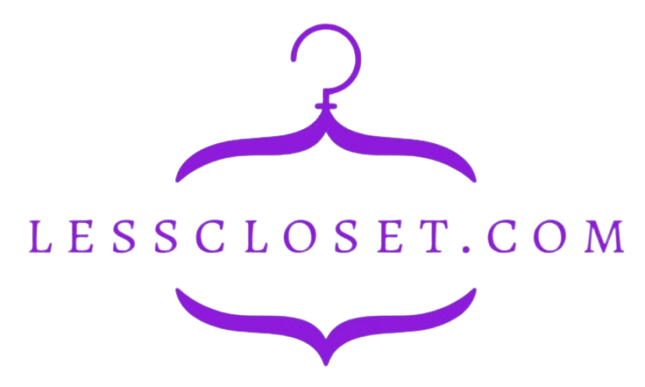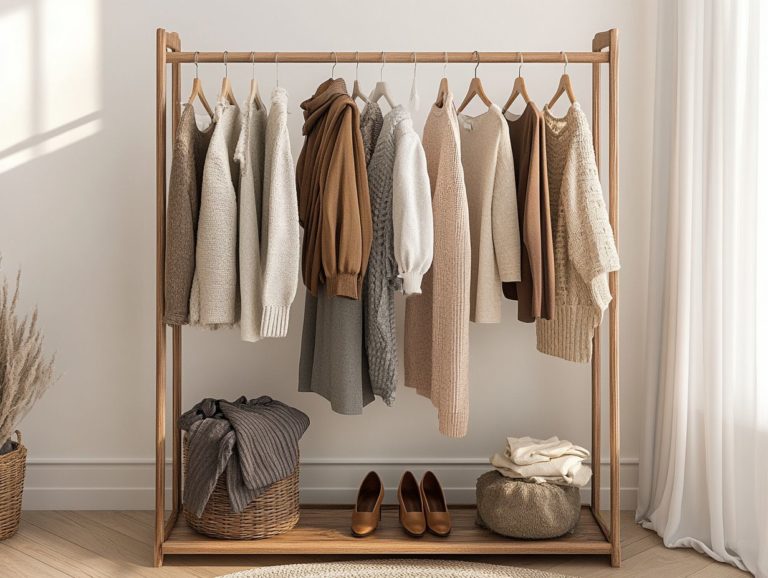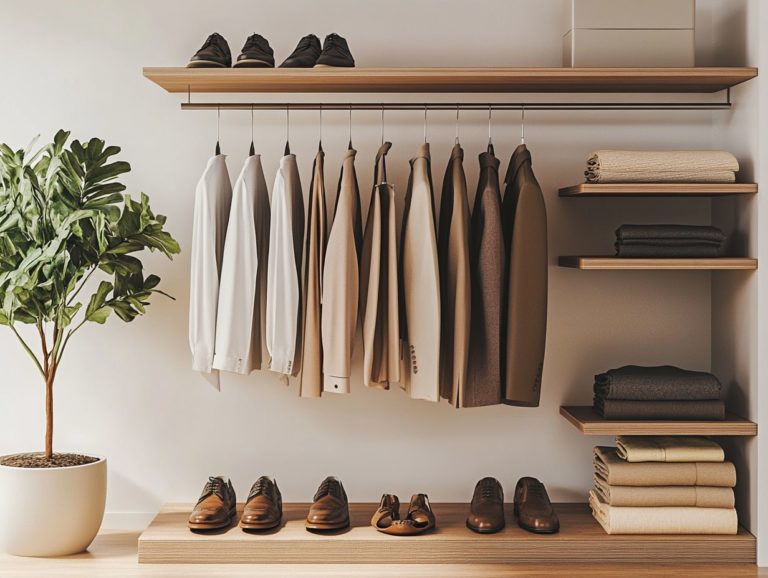What Does a Sustainable Wardrobe Look Like?
Join the sustainable fashion revolution! Your wardrobe choices matter more than ever. Let s explore how to make fashion that cares for our planet.
Sustainable fashion transcends mere trendiness; it embodies a thoughtful approach to clothing that places the well-being of our planet and its inhabitants at the forefront.
This article delves into the essence of sustainable fashion and underscores the importance of nurturing a sustainable wardrobe. You’ll explore practical strategies, from evaluating your current collection to engaging in ethical shopping and caring for your garments.
Uncover how your choices can foster a positive influence on both the environment and society, and gain insights into what constitutes a truly sustainable wardrobe.
Contents
- Key Takeaways:
- Understanding Sustainable Fashion
- Building a Sustainable Wardrobe
- Shopping Sustainably
- Maintaining a Sustainable Wardrobe
- Proper Care and Upcycling Techniques
- The Impact of a Sustainable Wardrobe
- Frequently Asked Questions
- What does a sustainable wardrobe look like?
- Why is it important to have a sustainable wardrobe?
- What are some key characteristics of a sustainable wardrobe?
- How can I transition to a sustainable wardrobe?
- What are some challenges of maintaining a sustainable wardrobe?
- Can I still be fashionable with a sustainable wardrobe?
Key Takeaways:

- A sustainable wardrobe is one that is built thoughtfully, with a focus on ethical and eco-friendly considerations.
- Shopping sustainably involves making conscious choices, such as buying from ethical brands and opting for second-hand items.
- Maintaining a sustainable wardrobe requires proper care and upcycling techniques, reducing waste and extending the lifespan of clothing.
Understanding Sustainable Fashion
Understanding sustainable fashion is crucial for making informed clothing choices that have a positive impact on both the environment and society.
This approach includes various practices designed to reduce the carbon footprint of the fashion industry, promote ethical brands, and encourage responsible consumerism.
A carbon footprint refers to the total greenhouse gases produced to support human activities, measured in units of carbon dioxide.
By reflecting on the social and environmental costs linked to your purchasing behavior, you can make a meaningful difference not only in your personal wardrobe but also in the broader fashion landscape.
Defining Sustainable Fashion
Sustainable fashion is all about clothing and accessories designed with a focus on minimizing environmental impact and promoting ethical consumption throughout their entire lifecycle.
This approach sharply contrasts with the fast fashion model, which rushes production and cuts costs, often compromising both quality and environmental health.
In sustainable fashion, the use of organic fabrics is essential; these materials are cultivated without harmful pesticides and synthetic fertilizers, which reduces pollution and nurtures healthier ecosystems.
Textile recycling plays a vital role in this movement, enabling worn garments to be reinvented into new products rather than languishing in landfills.
By emphasizing ethical practices, this responsible fashion movement advocates for fair labor conditions, ensuring that workers are treated with dignity while paving the way for a sustainable future in the industry.
The Importance of Sustainable Wardrobes
Sustainable wardrobes are game-changers in your pursuit of a greener lifestyle. They help you shrink your carbon footprint and make a positive impact.
By thoughtfully curating your collection, you can significantly reduce textile waste a pressing concern in the fashion industry.
This approach fosters a mindset of mindful consumption, encouraging you to prioritize quality and durability over fleeting fast fashion trends.
Choosing sustainable garments not only elevates your wardrobe, but also influences broader fashion behaviors and trends toward environmentally-friendly practices.
This collective shift encourages brands to adopt responsible manufacturing processes and materials, demonstrating the powerful impact of consumer choices in promoting sustainability within the fashion landscape.
Building a Sustainable Wardrobe
Building a sustainable wardrobe requires you to undertake a thoughtful audit, one that prioritizes clothing choices designed to minimize waste and encourage ethical consumption.
This means carefully selecting your wardrobe essentials, ensuring that each piece contributes positively to both your style and the environment.
Ready to revolutionize your wardrobe? Start today and be a part of the change!
Assessing Your Current Wardrobe

Assessing your current wardrobe through a thorough audit is an essential first step in crafting a sustainable collection. You can finally evaluate your clothing inventory and make informed choices about how you care for your garments.
By systematically sorting through each item, you ll pinpoint which pieces you genuinely wear and cherish. This allows you to prioritize quality over quantity. Take a moment to inspect the materials of each piece. Natural fibers like cotton, wool, and linen often require different care than synthetic materials.
Label your clothing based on their care needs to prevent unnecessary damage. This practice extends the life of your garments and nurtures eco-friendly habits. Such evaluations help create a more cohesive style while significantly reducing waste and promoting a circular fashion economy.
Key Elements of a Sustainable Wardrobe
The key elements of a sustainable wardrobe involve making intentional clothing choices. Prioritize ethical brands, vintage finds, and the potential for garment repairs, while keeping durability at the forefront.
This approach reduces your environmental footprint, champions fair labor practices, and promotes sustainable manufacturing methods.
Opting for vintage clothing can infuse new life into pre-loved pieces. You express your unique style while actively cutting down on waste. Embracing garment repairs fosters a mindset of longevity over disposability. This reinforces the belief that clothing can be cherished, maintained, and loved rather than simply tossed aside.
By considering these factors, you can play a vital role in promoting responsible consumption that supports both social and environmental well-being.
Shopping Sustainably
Shopping sustainably means embracing environmentally friendly habits that elevate your ethical shopping choices. This includes exploring the second-hand market and considering rental options for clothing that resonate with sustainable fashion principles.
By making these intentional decisions, you contribute to a healthier planet and redefine your personal style with unique finds.
Tips for Ethical and Eco-Friendly Shopping
When shopping, aim to discover ethical brands that prioritize sustainable practices. Consider using eco-friendly laundry products to extend the life of your garments.
Identifying these brands often means looking for certifications like Fair Trade or GOTS. These signal a commitment to ethical labor practices and the use of organic materials. Embracing vintage clothing supports the recycling of textiles and infuses your wardrobe with unique styles. Dive into local thrift stores or explore online platforms specializing in preloved items to uncover hidden gems!
When it comes to laundry, opting for eco laundry products is crucial. These products help reduce microplastic pollution, which refers to tiny plastic particles that harm marine life, making a meaningful impact on the environment.
Maintaining a Sustainable Wardrobe
Maintaining a sustainable wardrobe involves more than just your initial purchases. It requires you to embrace effective clothing care techniques and garment repairs.
By doing so, you can optimize the lifespan of your clothing and significantly minimize waste.
Proper Care and Upcycling Techniques

Caring for your garments the right way and embracing upcycling techniques can greatly extend the lifespan of your clothing. This approach champions eco-conscious living and sustainability while addressing the environmental costs.
By adopting mindful washing practices like using cold water and air drying you can prevent unnecessary wear on your favorite outfits. Learning to mend small tears or replace buttons revitalizes your wardrobe and ignites a sense of creativity and accomplishment.
Upcycling opens up many possibilities to transform outdated items into stylish statement pieces. This allows your personal style to truly shine. Each repair or redesign conserves resources and plays a vital role in reducing textile waste, making those simple acts profoundly impactful in the larger narrative of environmental conservation.
The Impact of a Sustainable Wardrobe
The impact of cultivating a sustainable wardrobe goes beyond personal advantages. It creates a ripple effect benefiting the environment and communities alike. By reducing fashion emissions and addressing the social costs tied to the fashion industry, you play a vital role in fostering a more responsible and ethical approach to clothing.
Environmental and Social Benefits
The environmental and social benefits of sustainable wardrobes are numerous. You can significantly reduce waste, lessen your overall environmental impact, and promote responsible consumerism within your community.
Act now! Invest in sustainable materials and ethical production processes. You play a vital role in fostering a circular economy that values longevity over disposability. This mindful approach decreases landfill waste and encourages brands to implement fair labor practices, enhancing the livelihoods of workers globally.
Sustainable wardrobes bring out stylish, timeless pieces that you’ll love to wear. As you and your community embrace these sustainable practices, you collectively pave the way for a more equitable and eco-friendly future. The choices you make today, including adopting zero waste fashion, nurture both people and the planet for generations to come.
Frequently Asked Questions
What does a sustainable wardrobe look like?
A sustainable wardrobe is made up of high-quality, ethically-produced, and environmentally-friendly clothing items. These items are worn and cared for with intention and longevity in mind. This includes organic fabrics, tailored clothing, and items that embody clothing sustainability.
Why is it important to have a sustainable wardrobe?

Having a sustainable wardrobe helps reduce the negative impact of the fashion industry on the environment. It promotes fair labor practices and encourages mindful consumption. This initiative also reduces the amount of clothing waste that ends up in landfills.
Join the movement for a sustainable future!
What are some key characteristics of a sustainable wardrobe?
A sustainable wardrobe includes durable, timeless pieces for various seasons. Versatile items that mix and match are essential, along with clothing made from sustainable materials like organic cotton or recycled polyester.
How can I transition to a sustainable wardrobe?
Start transitioning by evaluating your current clothing choices. Make informed purchases, consider second-hand options, and support brands focused on sustainability.
What are some challenges of maintaining a sustainable wardrobe?
Maintaining a sustainable wardrobe can be challenging. Higher costs and limited options require more time for research and ethical brand selection.
Can I still be fashionable with a sustainable wardrobe?
Absolutely! Sustainable fashion is stylish and creative. Upcycling old or secondhand clothes makes your wardrobe unique while reducing what s known as “fashion emissions,” which refers to the environmental impact of clothing production. Embrace the challenge of fashion with a sustainable wardrobe today! Your choices can make a real difference.



